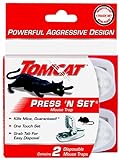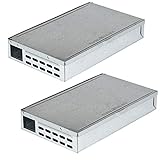To get rid of mice in walls, start by identifying and sealing their entry points, such as gaps around pipes and vents. Use steel wool or caulk for sealing. Set up traps or use rodenticides in areas where mice activity is suspected. For severe infestations, consider professional pest control services. Regularly inspect your home for signs of mice and maintain cleanliness to prevent future infestations.
Are you hearing the pitter-patter of tiny feet within your walls? You’re not alone. Out of the 9 homes we’ve owned, these unwanted guests have infiltrated at least half of them – and it’s not alot of fun to get rid of them.
As an experienced homeowner, and now the owner of a home advice blog, I thought this would be a valuable topic to write about for our readers. From understand their behavior to implementing humane and efficient solutions, we’ve got you covered. if we didn’t include “humane solutions”, my daughter, who is the Creative Director for Trustrowthyhomeadvice.com, might stage a walkout.
So, stay tuned as explore this common household problem, along with a few practical and easy-to-follow steps that you may not have been aware of.
How Do Mice Get Into Walls?
Mice are agile little creatures, capable of squeezing through extremely small gaps due to their flexible skeleton. They can easily invade homes through openings as small as small as 1/4″. Mice typically enter walls through gaps around pipes, vents, and other utility lines that lead into your home. They’re also adept climbers, often scaling walls to reach attic spaces or gaps in the roofline.

Sealing these entry points with steel wool or caulk can deter mice, but if you don’t get ALL of the potential access points, they will find the one you missed. Keep in mind also, mice can chew through many materials, so I included a list of things they can and cannot chew through:
What Mice CAN Chew Through (Read carefully):
Mice can chew trough Plastic, Vinyl, Rubber, Fiberglass, Aluminum (yes believe it or not – they can), foam rubber, wires, fabric, and even WATER PIPES, especially softer piping like PEX piping. They are capable of chewing through copper pipes, but it’s not that common, they can more easily chew through older piping that may be weakened by corrosion or just age.
What is amazing is that their front teeth are harder than copper or even iron. When measured on the Mohs hardness scale, they measure about 5.5, whereas, copper measures 3.0. To put this in perspective, Diamond is rated a 10 on the mohs scale, while Talc and Drywall are rated 1 and 2 respectively..
They tend to chew through water pipes because they are looking for water, but that’s not the only reason. Their teeth grow several millimeters every week, and they grow in a curved shape, so, gnawing on a curved surface like a water pipe is geometrically convenient for them to grind down that rapid growth.
They are also always on the hunt for water, so one way I’ve heard one methos to protect your pipes, which may seem like you are attracting them, is to place a small water tray near where you suspect an infestation. This will give them an option to chewing on your pipes, but it’s not guaranteed. It’s also something I personally just wouldn’t do. However, it may be a short term option to put in place until you get better solutions in place.
What Mice CAN’T Chew Through:
Mice generally cannot chew through Concrete, sheet metal, Glass, Rocks, Steel Wool and Brick. So if any of these materials are an option when sealing up a particular opening, use them.
Why Do Mice Move In?
Mice are attracted to areas with ample food and water. So this aspect is pretty simple, keep a clean home and make sure you are properly storing food.
Mice are also excellent swimmers. They may not be Michael Phelps, but they are capable of entering homes through drains or sewer lines. So, installing a one-way door or check valve in these areas can prevent mice from using this route. Make sure you check with a qualified plumber if you consider this option.
Lastly, mice are often drawn to clutter and debris. By maintaining a neat and organized yard and removing potential nesting sites, you can make your property less appealing to these pests.
Remember, prevention is key when it comes to keeping mice out of walls. By understanding how mice invade homes, you can take proactive steps to safeguard your property.
What Are Signs Of Mice In Walls?
Detecting the presence of mice in walls may not be as straightforward as it seems. However, there are certain signs that can tip you off. The most obvious is the sound of scratching and scurrying within the walls, particularly during the quiet nighttime hours.
Another common sign is the presence of mouse droppings. These small, dark pellets can often be found in areas where mice are active, such as under sinks, behind furniture, and along baseboards. Take a close look at the picture below, the dark pellets are intermixed with other debris that they have chewed. This is a typical sign that is consistent with how these little guys operate. The droppings are typically about the size of a grain of rice, and they can be a clear indication of a mouse infestation.

Mice are also known to cause structural damage to your home. As we discussed, they can gnaw through wood, drywall, and even electrical wiring, which can lead to serious problems like fires. If you notice unexplained damage around your home, investigate it carefully, it could be the work of mice or rats.
Another sign of mice in walls is the presence of nests. Mice tend to build their nests in secluded areas using soft materials like shredded paper, fabric, or insulation. If you find such a nest, it’s a clear sign of an infestation, even if there are no mice in it. We found a next with a few live baby mice in a sofa bed a few years ago. If you have a sofa bed, you probably don’t open it very often, so when you do, make sure you give it a through look see before tucking your “invited” house guests in.
Lastly, you may also notice a distinctive odor. Mice have a musky scent that can become quite strong when there’s a large population. This smell can often be detected in areas where mice are active.
Remember, if you notice any of these signs, it’s important to act quickly. Mice can reproduce rapidly (kind of like rabbits), and a small problem can quickly become a major infestation.
Are Mice In Walls Dangerous?
Mice in walls can pose a real threat to your health and home. They carry diseases such as Hantavirus, Salmonellosis, and Leptospirosis, which can be transmitted to humans through their urine, droppings, or saliva. The health risks associated with these diseases are serious, potentially leading to respiratory issues or even death in severe cases.
Mice also pose a structural threat to your home. They gnaw on wood, insulation, and electrical wires, which can lead to fire hazards. Furthermore, the constant scratching and gnawing sounds they produce can be quite disturbing, causing stress and sleep disturbances.
One effective method for eliminating these rodents is to use rodent traps. These can be baited with food and placed near the areas of activity. Another method is to use rodenticides, although they should be used with caution due to their potential harm to pets and children. We’ll do a detailed review on the best rodent traps for home use in the very near future.
- Seal all possible entry points: Mice can squeeze through tiny gaps, so it’s essential to seal all potential entry points.
Professional pest control services can also be considered for a more thorough and effective solution. They have the training and equipment to handle the situation safely and efficiently. Remember, the key to getting rid of mice in walls is to act promptly before the infestation becomes severe.
How To Locate Mice In Walls?
Pinpointing the exact location of the mice in walls can be tricky. This can be done by listening carefully for the sounds they make. Mice are most active during the night, so this is the best time to do this.
Once you’ve identified the general area where the sounds are coming from, you can confirm their presence by using a thermal imaging camera. This device can detect heat sources behind walls. These may not detect the actual rodent moving, but it they will detect nests if they have built any. I did some research on the best thermal imaging cameras and added a table from a more detaild post we are working on below. I included an aerial camera as well. This unit obviously will not detect mice in walls, but we kept it in the review as it is a great way to look for hot spots in a roof to detect insulation issues.
Best Thermal Imaging Cameras
| OVERALL BEST | RUNNER UP | ENTRY-LEVEL PROFESSIONAL USE | SMARTPHONE INTEGRATION | AERIAL THERMAL IMAGING |
|---|---|---|---|---|
| FLIR TG267 | Seek Compact Pro | FLIR C5 | Fluke FLK-TIS20+ | DJI Mavic 2 |
 |
 |
 |
 |
 |
| Check Price on Amazon | Check Price on Amazon | Check Price on Amazon | Check Price on Amazon | Check Price on Amazon |
Another method is the use of fluorescent powder. This powder can be spread around suspected entry points. If mice are present, they will walk through the powder, leaving a trail that can be seen under UV light.
If you’re still unable to locate exact location of the the mice, consider hiring a professional pest control service. These experts have the necessary tools and knowledge to effectively locate and eliminate mice infestations in walls.
Remember, act swiftly once you’ve located mice in your walls. The longer they remain, the more damage they can cause to your home. Implementing a mouse control strategy is key to preventing future infestations. This includes sealing entry points, removing food sources, and using traps or poison.
How To Remove Mice From Walls?
OK, you found where they are, narrowed down your search, so how do you issue an eviction notice? One of the most effective ways to remove mice from walls is through the use of rodenticides. These are usually in pellet form and can be placed in areas where mice activity is suspected. However, caution must be taken as these substances can be harmful to pets and children if ingested.
Then there’s the tried and true use of traps. Mouse traps can be baited with food items such as cheese or peanut butter, and strategically placed near the walls. I’ve used almost every type of trap out there over the year, so I’ve written a detailed review of the Best traps for 2023, read out review here. Here’s the summary table form that review with the Top-5 Traps.
The Top 5 Mouse Traps in 2023
| OVERALL BEST | RUNNER UP | BEST FOR BUDGET | EASE OF USE | MULTIPLE CATCHES |
|---|---|---|---|---|
| Victor Electronic | Victor Metal Pedal | Tomcat Press ‘N Set | Victor Tin Cat | Tomcat Glue |
 |
 |
 |
 |
 |
| Check Price on Amazon | Check Price on Amazon | Check Price on Amazon | Check Price on Amazon | Check Price on Amazon |
For a more humane approach, live traps can be used. These traps capture mice without killing them, allowing you to release them. However, this method requires regular checking of the traps to ensure the mice are not left inside for extended periods. You also should release them at least 2 miles from your home, or they may want to check back in.
If the infestation is severe, it may be time to break down and call in professional pest control services. These experts have the knowledge and equipment to effectively remove mice from walls and prevent future infestations for the most difficult situations.
In addition to these methods, it is essential to seal any cracks or holes in the walls where mice may enter. By doing so, you can prevent future infestations and maintain a mouse-free environment.
Remember, the best defense against mice in walls is prevention. Regular home inspections and maintenance can go a long way in keeping these pests at bay.
What Tools Are Needed To Remove Mice?
When dealing with a mouse infestation in your walls, the right tools can make a significant difference. Firstly, a high-frequency ultrasonic rodent repeller can be a handy device. Emitting sounds that are intolerable to mice but not noticeable to humans, this device can effectively drive mice out of your walls.
Secondly, mouse traps are essential. Choose from snap traps, live catch traps, or glue traps depending on your preference. Remember to bait these traps with food items that are attractive to mice, such as peanut butter or cheese.
In addition, a sealant is necessary for closing off entry points once the mice have been removed. Mice can squeeze through openings as small as a quarter of an inch, so it’s crucial to seal any potential entry points.
Lastly, consider investing in protective gear. This includes gloves and a mask to protect yourself from potential diseases that mice may carry.
Remember, while these tools can help, professional pest control services may be necessary for severe infestations. They have the expertise and equipment to handle the situation effectively and ensure that the mice do not return.
How To Prevent Mice From Entering Walls?
Preventing mice from entering walls begins with a thorough examination of your home’s exterior. Look for any tiny openings or cracks as mice can squeeze through a hole as small as a dime. Sealing these entrances with steel wool or caulk can significantly reduce the chances of mice invasion.
Another effective method is to maintain cleanliness in your home. Mice are attracted to food scraps and clutter, so regular cleaning and proper food storage can deter these pests. Trimming overgrown shrubbery and branches that touch your home can also discourage mice from finding their way into your walls.
Installing door sweeps on exterior doors is another preventive measure. This not only prevents mice from entering but also helps in energy conservation.
- Use of mouse deterrents: Natural deterrents like peppermint oil, mothballs, and ultrasonic devices can help in keeping mice away.
Lastly, consider professional pest control services if the problem persists. They have the necessary equipment and knowledge to handle severe infestations and can provide advice on long-term prevention strategies. Remember, the key to preventing mice from entering walls is a combination of regular maintenance, cleanliness, and proactive prevention measures.
What Are The Best Mice Repellents For Walls?
When it comes to eliminating mice from your walls, choosing the right repellents is crucial. The market offers a myriad of options, each with its unique features and effectiveness. One of the most popular repellents is the ultrasonic pest repeller. These devices emit high-frequency sound waves that are intolerable to mice, driving them away from your walls.
Another potent solution is the use of peppermint oil. Mice detest the strong scent of peppermint, making it an effective natural repellent. Simply soak cotton balls in the oil and place them in areas where you suspect mouse activity.
Mothballs are also commonly used to deter mice. However, their toxic nature makes them unsuitable if you have pets or children in the house.
Electronic mouse repellents are a safe and humane solution. These devices emit electromagnetic fields that disrupt the nervous system of mice, forcing them to leave your walls.
– Mouse traps are traditional yet effective methods. These traps can be baited with food and placed strategically inside the walls through small holes.
Lastly, professional pest control services should be considered when dealing with severe infestations. They offer comprehensive solutions that not only eliminate the existing problem but also prevent future infestations. Always remember, the key to successful mice control is early detection and immediate action.
Wrapping Up: The Battle Against Mice in Walls
In conclusion, the issue of mice in walls is more complex than it might initially seem. Understanding how mice get into walls is the first step in addressing the problem, followed by recognizing the signs of their presence. It’s crucial to be aware that mice in walls pose a potential danger, making prompt action necessary.
Locating and removing mice from walls can be a challenging task, requiring specific tools and knowledge. However, it’s not an insurmountable problem. With the right approach, you can effectively rid your walls of these unwanted guests.
Prevention is just as important as removal when it comes to dealing with mice in walls. By taking proactive measures, you can significantly reduce the chances of a re-infestation. Using the best mice repellents for walls can play a vital role in this aspect.
As we move forward, advancements in pest control methods and tools may provide even more effective solutions for dealing with mice in walls. It’s important to stay informed about these developments and adapt your approach accordingly.
Remember, dealing with mice in walls is not just about getting rid of a nuisance. It’s about ensuring the safety and integrity of your home.




